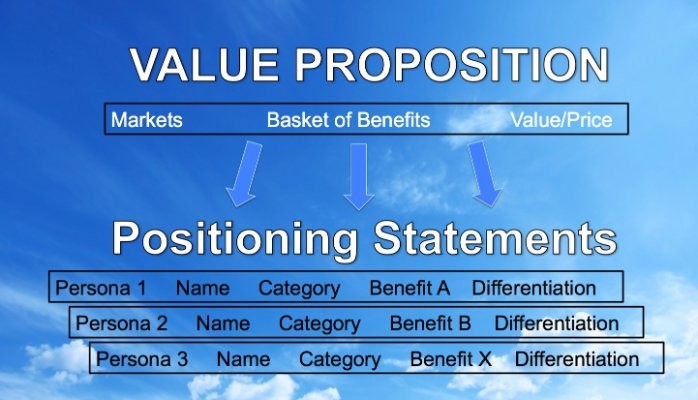
Value Propositions vs. Positioning Statements: What's the difference?
Confused about the difference between positioning statements and value propositions? You're not alone. These terms are often used interchangeably, but they mean very different things.
Value propositions refer to the "big picture." Value propositions are broad in nature and are a direct output of a company's business strategy. They reflect your brand promise along with a basket of benefits offered to multiple market segments and the price the customer pays for those benefits. A company's value proposition is often found in the business plan and or in a market requirements document (MRD). Business units, strategic marketers, and/or product marketers are usually responsible for developing the value proposition.
Positioning statements, on the other hand, reflect a subset of the value proposition. Positioning statements are used in marketing communications (marcom) programs and activities. The positioning statement includes the target audience (persona), product name, category, benefit, and competitive differentiation. Most importantly, positioning statements represent a plea for single-mindedness when it comes to communicating specific marketing messages aimed at very specific audiences. While the value proposition reflects the wider range of primary benefits offered, the positioning statement points a laser beam at only the most relevant benefit and points of competitive differentiation that are meaningful to a carefully targeted persona. Positioning statements are usually developed by product marketers with input from corporate marketers. Positioning statements are a necessary ingredient of any integrated marketing communications plan or creative brief.
Also read: Do we really need a positioning statement?
A single value proposition may overlap or be comprised of multiple positioning statements. They are both tools used by marketing teams to focus their campaigns, programs, and activities. However, neither provide the exact wording that should be used in any customer messaging. For that, you need the message box.
For more examples and in depth analysis of positioning statements (along with personas and customer-ready messaging), please check out the B2B marketing guidebook, The Marketing High Ground.
Invest in your marketing team: It can be hard to find time to attend a conference, workshop, or an MBA program in order to grow your skills. That's why I wrote several marketing books for B2B marketers and created a new series of online courses created specifically for busy B2B marketers. Check them out. I'd love to know what you think.
* Online course -- Product Management & Marketing: Personas
* Online course -- Product Management & Marketing: Positioning Statements
* Online course -- Messaging: How to Create a Killer Elevator Pitch
Mike Gospe is a co-founder of KickStart Alliance, a sales and marketing leadership consulting team. Mike leads executive workshops with CEOs and executive staffs to focus and clarify vision and mission statements, corporate strategies, product roadmaps, and go-to-market plans. He is also a professional facilitator with a focus on Customer Advisory Boards. Mike's passion to is help B2B leaders build a stronger connection with their best customers. Contact Mike to learn more about his best practices and services.
_____
NEW FOR 2018: Based on the popularity of this blog post, several marketers have asked me if I coach or mentor marketing directors/VPs on this and a wide-range of other marketing topics. The answer is yes. If you'd like to learn more, please contact me at mikeg@kickstartall.com.
Brand Design || Web Design
2yHi Mike, thanks for this amazing article. it clarified a lot for me. I'll like to ask - When a brand has more than one positioning statement for its different personas, won't it lead to confusing messaging. Or better asked, how can a brand utilise more than one positioning statement without confusing its audience?
Strategy & Finance||2024 MBA Candidate, UA Business School ||2020 Montpellier Business School & Foundation of France Laureate||
3yGreat article
Global Marketing Manager Consumables (International) Eppendorf Group
3yThank you for this clear statement!
Content Creator. Marketing Strategist. Social Media Expert.
4ySuper helpful article!